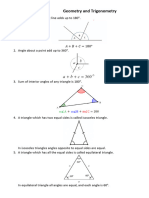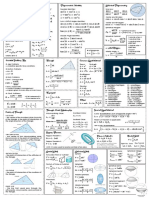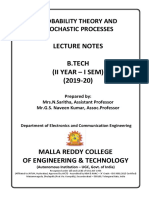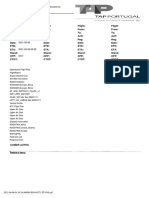Maths Grade 10
Uploaded by
Knife KelilMaths Grade 10
Uploaded by
Knife KelilSecond Semester Mathematics summarized note for Grade 10, September/2013 E.
SUMMURY ON UNIT 6
The acute angle formed by a horizontal line and the line of sight above the horizontal
line is called an angle of elevation
The angle formed by a horizontal line and the line of sight below the horizontal line is
called an angle of depression.
A median of a triangle is a line segment drawn from any vertex to the mid – point of the
opposite side
2
The medians of a triangle are concurrent at a point 3 of the distance from each vertex to
the mid – point of the opposite side that is, in the above triangle we have the following
relations
The altitude of a triangle is a line segment drawn from a vertex perpendicular to the
opposite side, or to the opposite side produced.
A segment that divides another segment into two equal segments is called side
bisector
A line segment that passes through the mid – point of a side of a triangle and
perpendicular to that side
The perpendicular bisector of a side of a triangle is equidistant from the three vertices
of a triangle
An angle bisector of a triangle is a segment that bisects an angle of the triangle
and has one end point at a vertex of the triangle and the other end point at another
point of the triangle.
The angle bisector of a triangle is equidistant from the sides of a triangle.
Every triangle has three angle bisectors and they intersect each other at a
common point called incentre.
Altitude theorem
̅̅̅̅ to the hypotenuse
If a right angled triangle ABC with altitude 𝐶𝐷
̅̅̅̅̅
𝐴𝐵 is given, then CD2 = (AD) (DB).
Read More! Save Your life!
A quadrilateral is trapezium if it has exactly one pair of opposite sides parallel.
Parallelogram is special quadrilateral with both pairs of opposite sides parallel
Special parallelograms are rectangle, rhombus and square
Rectangle is a parallelogram with one of its angle is right angle \
A rhombus is a parallelogram with four congruent sides
Square is a rectangle with congruent adjacent sides
A circle is a plane figure, all points of which are equidistant from a given point
called the centre of the circle.
̂ is a minor arc. <BOC is a central
If A and C are not end – points of a diameter, 𝐴𝑋𝐶
̂ is said to subtend < AOC.
angle. 𝐴𝑋𝐶
The measure of an angle inscribed in a a circle is half the measure of the arc
subtending it
an angle inscribed in a semi – circle is a right angle or 900
An angle inscribed in an arc less than a semi-circle is obtuse
An angle inscribed in an arc greater than a semi – circle is acute.
An angle formed by a tangent and a chord drawn from the point of tangency is
measured by half the arc it intercepts.
The measure of an angle formed by two chords intersecting inside a circle is half the
sum of the measures of the arc subtending the angle and its vertically opposite angle.
The measure of the angle formed by the lines of the chords intersecting outside a circle is
half the difference of the measure of the arcs they intercept.
̂ ].Moreover,
̂ ) − 𝑚(𝐴𝑋
m(<p) = ½ [m(𝐵𝑌
(PA) (PB) = (PX) (PY)
If a secant and a tangent are drawn from a point outside a circle, then the square of the
length of the tangent is equal to the product of the lengths of line segments given by
(PA)2 = (PB) (PC)
Read More! Save Your life!
Regular polygon is a convex polygon in which all of its sides and the measure of each
interior angle is the same
The area ‘A’ , a apothem ‘a’ , perimeter ‘P’ , side length’s ‘ of a regular n – sided
polygon inscribed in a circle of radius r is given by the following relations
3600 1
A = ½ nr2 sin = 2 ap
𝑛
1800
a = r cos 𝑛
1800
s = 2r sin 𝑛
1800
P = ns = 2nr sin 𝑛
SUMMURY ON UNIT 7
prism is a solid figure bounded by plane faces of which two called the ends ( bases ) are
congruent figures in parallel planes and the others called side – faces are parallelograms
If we denote the lateral surface area of the prism by AL, the area of the base Ab , altitude h
and the total surface area by AT , then
i. A L = Pbh
ii. AT = 2Ab + AL
iii. V = Ab h where Pb – perimeter of base &V – Volume of the prism
For a right circular cylinder
i. AL = 2rh where r is the radius of the base of the cylinder
i. ii. AT = 2r(r + h)
ii. iii.Volume (V) = Ab h = r2h
The solid figure formed by joining all points of a circle to a point not on the plane of the
circle is called a cone
A pyramid is a solid figure formed when each vertex of a polygon is joined to the same
point not in the plane of the polygon.
The solid figure formed by joining all points of a circle to a point not on the plane of the
circle is called a cone.
The following formulas are used for both regular pyramids and cones
Read More! Save Your life!
Lateral surface area = ½ pℓ , where p – perimeter of base
ℓ - slant height
AT (total surface area) = AB + ½ Pℓ AB – Area of base
1
Volume (V) = 3 AB h . . . . . . . . .. . .. h – height of the pyramid
A sphere is a closed surface,all points of which are equidistant from a
point called the centre.
If a pyramid or a cone is cut by a plane parallel to the base,the
intersection of the plane and the pyramid (or the cone) is called a
horizontal cross-section of the pyramid(or the cone).
Frustums of pyramids and cones
If a pyramid or a cone is cut by a plane parallel to the base, the intersection of the plane
and the pyramid (or the cone) is called a horizontal cross – section of the pyramid or the
base.
𝑘2
For any pyramid, the ratio of the area of a cross – section to the area of the base is ℎ2
where h is the altitude of the pyramid and k is the distance from the vertex to the
plane of the cross – section
Frustum of a pyramid
Frustum a pyramid is a part of the pyramid included between the base and a plane
parallel to the base
The base of the pyramid and the cross – section made by the plane parallel to it
are called the bases of the frustum. The other faces are called lateral faces. The
total surface of a frustum is the sum of the lateral surface and the bases
The altitude of a frustum of a pyramid is the perpendicular distance between the
bases
Frustum of a cone
Frustum of a cone is a part of the cone included between the base and a horizontal cross
– section made by a plane parallel to the base
The altitude is the perpendicular distance between the bases
The slant height of a frustum of a right circular cone is the part of the slant height of the
cone which is included between the bases.
The lateral surface area (AL) of a frustum of a regular pyramid is equal to half the product
of the slant height (ℓ) and the sum of the perimeter (p) of the lower bases and the
perimeter (P|) of the upper base. That is
AL = ½ ℓ (P + P1) and AT = AL + AC + Ab
Ac – are of cross section
Ab – area of ba
Read More! Save Your life!
For a frustum of a right circular cone with altitude h and slant height ℓ , if the
circumferences of the bases are C| and C, then the lateral surface area of the frustum is
given by
AL = ½ ℓ (C+C|) = ℓ(r+r|)
Note: r and r| are radiuses of the bases of the cone and cross – section
2
AT = = AL + r2 + 𝑟 1
The formula for finding the volume of a frustum of a cone or pyramid as follows
ℎ|
Vf = (A + A|+√𝐴𝐴| )
3
Where A is the lower base area, A| is the upper base area and h| is the height of a frustum of a
cone or pyramid
The formula for finding the volume of a frustum of a cone in terms of r and r| as follows
ℎ | 2
Vf = (r + (r1)2 + rr|)
3
Where r is the radius of the bigger (the lower base of the frustum cone and r| is the radius
of the smaller cone (upper base of the frustum)
Read More! Save Your life!
You might also like
- SET A.2 Plane, Solid, and Analytic GeometryNo ratings yetSET A.2 Plane, Solid, and Analytic Geometry79 pages
- SOLMEN 112 - Module 1-Introduction and TrianglesNo ratings yetSOLMEN 112 - Module 1-Introduction and Triangles6 pages
- MODULE 1 Plane Geometry Introduction and Triangles 1100% (1)MODULE 1 Plane Geometry Introduction and Triangles 17 pages
- BASIC- Mathematics Module 4- V1 [Compatibility Mode]No ratings yetBASIC- Mathematics Module 4- V1 [Compatibility Mode]48 pages
- Topic 6 - Plane Figures Plane Geometry Is Division of Geometry Concerned About100% (1)Topic 6 - Plane Figures Plane Geometry Is Division of Geometry Concerned About15 pages
- Toaz - Info Solid Mensuration Formulas PDF PRNo ratings yetToaz - Info Solid Mensuration Formulas PDF PR2 pages
- Geometry - Quantitative Aptitude For CAT EBOOK100% (1)Geometry - Quantitative Aptitude For CAT EBOOK12 pages
- Solid Mensuration: Mr. Mark Jave C. Gualberto, RME Lecturer I100% (1)Solid Mensuration: Mr. Mark Jave C. Gualberto, RME Lecturer I21 pages
- Trigonometry Plane&Solid Geometry: By: Engr. Roy Andrew Garcia100% (1)Trigonometry Plane&Solid Geometry: By: Engr. Roy Andrew Garcia50 pages
- 26_Mathematics_Properties of Triangle Solutions of TriangleNo ratings yet26_Mathematics_Properties of Triangle Solutions of Triangle19 pages
- 1 Minute of Arc 1 Nautical Mile 1 Statute Mile 1 KnotNo ratings yet1 Minute of Arc 1 Nautical Mile 1 Statute Mile 1 Knot1 page
- Spherical Trigonometry, For The Use Of Colleges And Schools, With Numerous ExamplesFrom EverandSpherical Trigonometry, For The Use Of Colleges And Schools, With Numerous ExamplesNo ratings yet
- The Elements of Euclid for the Use of Schools and Colleges (Illustrated)From EverandThe Elements of Euclid for the Use of Schools and Colleges (Illustrated)No ratings yet
- Curvilinear Perspective: Exploring Depth Perception in Computer VisionFrom EverandCurvilinear Perspective: Exploring Depth Perception in Computer VisionNo ratings yet
- An Introduction to Differential Geometry - With the Use of Tensor CalculusFrom EverandAn Introduction to Differential Geometry - With the Use of Tensor Calculus4/5 (1)
- Report FinalReport Jan6SelectCommittee PDF100% (1)Report FinalReport Jan6SelectCommittee PDF845 pages
- Hacking - Become A World Class Hacker, Hack Any Password PDF100% (5)Hacking - Become A World Class Hacker, Hack Any Password PDF69 pages
- Marketing To Youth in The Digital Age: The Promotion of Unhealthy Products and Health Promoting Behaviours On Social MediaNo ratings yetMarketing To Youth in The Digital Age: The Promotion of Unhealthy Products and Health Promoting Behaviours On Social Media3 pages
- Httpsmymodules - Dtls.unisa - Ac.zapluginfile - Php17819102mod foldercontent0INS3705202024 TL 101 3 B.pdfforcedownload 1No ratings yetHttpsmymodules - Dtls.unisa - Ac.zapluginfile - Php17819102mod foldercontent0INS3705202024 TL 101 3 B.pdfforcedownload 124 pages
- 6.08 - Intro To EECS Via Interconnected Embedded Systems - MIT AdmissionsNo ratings yet6.08 - Intro To EECS Via Interconnected Embedded Systems - MIT Admissions24 pages
- School of Distance Education: Andhra UniversityNo ratings yetSchool of Distance Education: Andhra University2 pages
- International Association For The Study of Traditional Environments (IASTE)No ratings yetInternational Association For The Study of Traditional Environments (IASTE)12 pages
- Probability Theory and Stochastic Processes0% (1)Probability Theory and Stochastic Processes155 pages
- SolidWorks Tutorial 2 Voor Lager en Middelbaar Onderwijs (2020)No ratings yetSolidWorks Tutorial 2 Voor Lager en Middelbaar Onderwijs (2020)27 pages
- Expansion of Osmani International Airport, Sylhet (1St Phase) Rate AnalysisNo ratings yetExpansion of Osmani International Airport, Sylhet (1St Phase) Rate Analysis8 pages
- CARPROG Mercedes Benz Airbag Reset ManualNo ratings yetCARPROG Mercedes Benz Airbag Reset Manual4 pages
- niir-directory-database-india-professionals-architects-interior-decorators-building-contractors-property-dealers-real-estate-agents-brokers-developers-builders-delhi-amp-ncr-region-construction-materialsNo ratings yetniir-directory-database-india-professionals-architects-interior-decorators-building-contractors-property-dealers-real-estate-agents-brokers-developers-builders-delhi-amp-ncr-region-construction-materials11 pages
- Let Me Introduce Myself: School SubjectsNo ratings yetLet Me Introduce Myself: School Subjects1 page

























































































